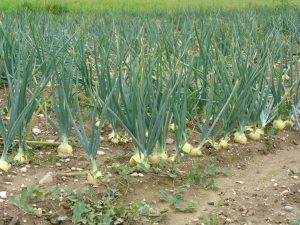Does a cook ever have enough onions? Pungent bulb onions are great and add flavour to any meal. I must say, we Zambians use onions in everything. As an agricultural farmer in Zambia, you need to tap into this need. So, if you’re thinking about growing onions on a large scale, then this article could help you make that decision.
How to grow onions
You can grow onions can from seeds, transplants (seedlings) or sets (small bulbs/onions). Transplants are seedlings grown in the current season and sold in bunches. They form good bulbs quickly but are subject to diseases. Sets are immature bulbs grown the previous year and are the easiest to plant, the earliest to harvest and the least susceptible to diseases.

The main advantage to growing onions from seed is that seeds are much cheaper. Also, they have the potential to produce larger bulbs. But, they require a little more time and effort. You also need to grow seeds in a greenhouse first i.e. indoors under bright fluorescent lights. So if you want to plant directly in the garden, then opt for sets.
The planting process
Onions like cool weather in the early part of their growth, so plant them before it gets too hot. Choose a section with the least weeds. It has to be sunny with fertile and well-drained soil.
Plough the soil to at least 30 cm deep. Mix in a 3cm layer of mature compost and make beds. In between the beds, make a 10cm deep, V-shaped furrow.
Fill the bottom of the furrow with 3cm of rich compost or fertilizer, and then water the prepared furrow. Plant seedlings or sets 3 to 6 inches apart, depending on the plants’ mature size.
As the onions start to grow, you need to move the soil away from the top of the bulbs. Exposure to the air helps the papery skin firm up, preventing rot. Leave only the lowest part of the bulb in contact with the earth.

Harvesting your onions
Onions need a long growing season. It’s easy to harvest them by pulling them out of the ground. Once onion tops start to turn yellow, use the back of a rake to bend them over horizontally. A day or so later, the tops will turn brown. This is time to pull or dig the bulbs on a sunny day, and leave them to dry in the sun. The most important thing is to cure the bulbs. This means allowing them to air-dry for about a month with their tops on.
When the outer skins are thoroughly dry, wipe off any soil and remove the tops—unless you intend to braid them. Store in a cool, dry place; hang braided onions or those kept in mesh bags in an airy spot. Such dried bulbs will keep for about 4 months to 1 year.
Do this to prevent pests in future harvests
Onion root maggots eat onion roots and bulbs.Especially when the Zambian rainy season is in full swing. Also, rotting onions attract adult flies. So, rotate onions with other crops. Avoid planting onions continuously in the same place. Furthermore, planting late can help you avoid this pest. But if you plant now, you can use row covers which is when the egg-laying females are most active.
It’s important to keep areas near onions mowed to reduce the weedy habitat that onions prefer. Use a spinosad-based biological pesticide to control serious infestations. Pink root and several other soil borne diseases can cause onions to rot. Use resistant varieties, and grow all onions in well-drained sites.

hello, I want to grow onions.which variety is good between white and red,I also want advice when to apply fertiliser.
hello, I want to grow onions.which variety is good between white and red,I also want advice when to apply fertiliser.
Hi Lungowe,
There’s no difference when growing onions, red or white. There main difference is the flavour, with white onions being stronger than the red. In addition, red have a shorter storage life compared to white onions.
With regards to fertiliser, onions don’t like a lot of fertilizer but do like rich soil. Once the onions are established (three weeks after planting), they’ll require more nitrogen for leaf formation but this also depends on the kind of fertiliser you’ll be using. In other words, a strong top growth is vital for onions and should guide you.
Its a good plant for farm beginners,because it does not require too much.Very good start up farm little capital.Thanks for sharing the information on how to grow those 2 types of onions.Am one of those with high interest in farming with no land and capital.
I want to grow Onions but I have little Idea please help anyone who has information to help me.
Can i plant long day onions in October and then transport them in December for an early crop in Zambia?
Can I make onion nursery and transplant in December? I am in region 111
I have budgeted to grow rainfed onion insitu. Which is the right month to plant?
Hello, is this a good time to plant onions? Red onion to be precise
… [Trackback]
[…] Read More here: agricultureinzambia.com/onions-low-maintenance-crops-beginner-farmers/ […]
Is it right to grow onion in December in an open rainfed area ?
I have inerest to grow onion which variety matures early and how is the market for onion.I want to take it as my formal job because jobs in Zambia are scarce.
Is october/november the right time to plant red onion